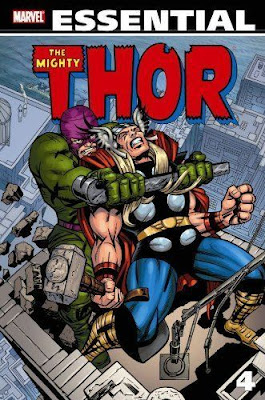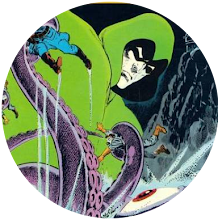 As I mentioned the other day, I've recently bought a pile of Marvel Essentials and, being the Thor fan that I am, I was never in any doubt which was going to be the first one I read.
As I mentioned the other day, I've recently bought a pile of Marvel Essentials and, being the Thor fan that I am, I was never in any doubt which was going to be the first one I read.Like a good football match, The Essential Thor Volume 4's a game of two halves. The first dominated by the latter days of Jack Kirby, the second by John Buscema, with a well-known guest artist to keep us entertained at half-time.
It all kicks off with Thor sent on a quest to discover the origin of Galactus. Whilst it's good to see Galactus again, his origin turns out to be something of a let down, as we discover he's just some bloke who got exposed to radiation, grew big and started eating everything. By this point we'd seen so many Marvel characters who'd got their start by being exposed to radiation that it all feels way too humdrum an explanation for Marvel's biggest of Big Bads.
Once this tale's done, the remainder of Jack Kirby era spends most its time reworking older stories as we get a rematch with the Wrecker, the Circus of Crime and Ulik. Even the new villain Crypto-Man features in a story that's a fairly blatant rehash of the Replicus tale from issue #141. While these tales are all fun, it's hard to avoid the feeling that, as with The Fantastic Four, by the time he'd left, Kirby's best work on the strip was already waving to him in the rear-view mirror.
As though to prove it, the major storyline of this late Kirby period's a straight reworking of the first Mangog outing when, thanks to getting his hands on the Odin-Ring as Odin sleeps, Loki seizes the throne of Asgard - only for Surtur to inconveniently appear and attack the kingdom. As in the Mangog tale, all seems lost until Odin awakes from his slumbers to dispatch the threat with no noticeable difficulty.
After this is we get an odd little tale - presumably a last minute fill-in - in which John Buscema takes over for an issue to give us Thor versus the Abomination. It's a tale that reveals that Thor can turn back time, which he's never done before and which you would've thought makes him effectively unbeatable.
Jack Kirby returns for just one issue before departing for good, followed by Neal Adams' debut on the strip as Thor and Loki swap bodies in a tale involving Mephisto. I'm not convinced it's a happy debut. It all looks as slick as you'd expect but Joe Sinnott's inks are so distinctive that, however polished it is, it looks more like Rich Buckler's Neal Adams impersonation than it does the real thing. For me it also lacks the dynamism of both Kirby and his long-term successor.
That successor is John Buscema who returns with a Dr Doom scrap before it's back into epic territory with the tale of Infinity, a star-devouring hand that turns out to be Odin's dodgy side unleashed by Hela.
Happily Infinity's seen off.
Not so happily, Hela's in a bad mood about the foiling of her plans, and kills Thor, only for wimpy old Sif to touch the Death Goddess with her tears, causing Hela to bring him back.
Unfortunately when they all return to Asgard, Loki's got his hands on the Odin-Ring (again) and has seized the throne (again). Instead of giving Loki a good smacking like he should, Odin stays as annoying as ever and goes off to have a kip, leaving Loki to do whatever he wants.
What he wants is to get his leg-over with Sif and create a creature called Durok the Demolisher who spends a fair amount of time knocking Thor around before knocking the Silver Surfer around. Highlight of all this has to be Durok smashing the Surfer's board to pieces. I always liked to see the Surfer suffer.
But there's still no rest for the dunderheaded because, having finally woken up, Odin banishes Loki to the place where Mangog's buried. Needless to say it's not long before the block headed villain releases the monster, and Odin has to thus send our cast off on yet more quests. At this point we meet the Asgardian warrior woman Hildegarde. Hildegarde as a character's great but has one obvious flaw which is that, with her rugged fighting ways, she really does rub-in what a complete and total wet dish-cloth Sif is in comparison.
You can't get away from it that there's an awful lot of repetition going on in these tales, with two reruns of the original Mangog tale and two epics involving Loki taking over Asgard by getting his hands on the Odin-Ring. Just how stupid is Odin that he learns nothing from the earlier problems and still leaves the Odin-Ring lying around for Loki to find? It's also annoying that Odin keeps going into the Odin-Sleep every time he's needed. You really do wonder why the people of Asgard revere the useless old berk.
But there're new ideas too - the main ones being to do with the characters. Freed from the constraints of working with the more concept-oriented Kirby, Stan Lee clearly starts to remodel the strip the way he wants it to be, as grandiose soap opera. This is no bad thing. As the strip goes along it's obvious it's becoming more and more an ensemble piece and less and less a solo strip, as Balder, Volstagg, Fandral and Hogun get more and more page time.
They're not the only ones. Once Gerry Conway takes over the writing chores, there's also the introduction of the strapping Hildegarde, brought in to accompany the increasingly useless Sif on a mission, while, before Lee goes, Hela, rarely seen in the strip before this era, gets noticeably more involvement.
But perhaps the most interesting thing about these tales involves Karnilla the Norn Queen, as we see her gradually evolving from out-and-out villain to a more ambiguous figure, purely through her love for Balder. Balder meanwhile finds himself torn from emotional pillar to post as he tries to balance his love for Karnilla with his sense of duty to Thor, Odin and Asgard. To a large degree, although the comic's called Thor, these are really the adventures of Balder and Karnilla, and the strip's all the better for it.











































































2 comments:
I've got this volume and you sure get value for money with it - it's as thick as an old 'phonebook. I've also got most of the stories in their Masterworks printings and I have to say that, although I like the black and white Essentials, colour really gives these tales a whole new dimension. The Masterworks editions allow the reader to savour the stories, but the Essentials are good, basic reading copies.
I have great childhood memories of Thor #s 154 through 157 courtesy of their reprinting in Marvel Treasury Edition #10. Seeing Kirby's artwork in oversized coloured glory struck a chord with me. There are some great memorable images from that issue. Also quite memorable in a humourous mode was Thor's encounter with some exaggerated New York hippies: "Tell it to the squares, dad! We dropped out!"
Post a Comment